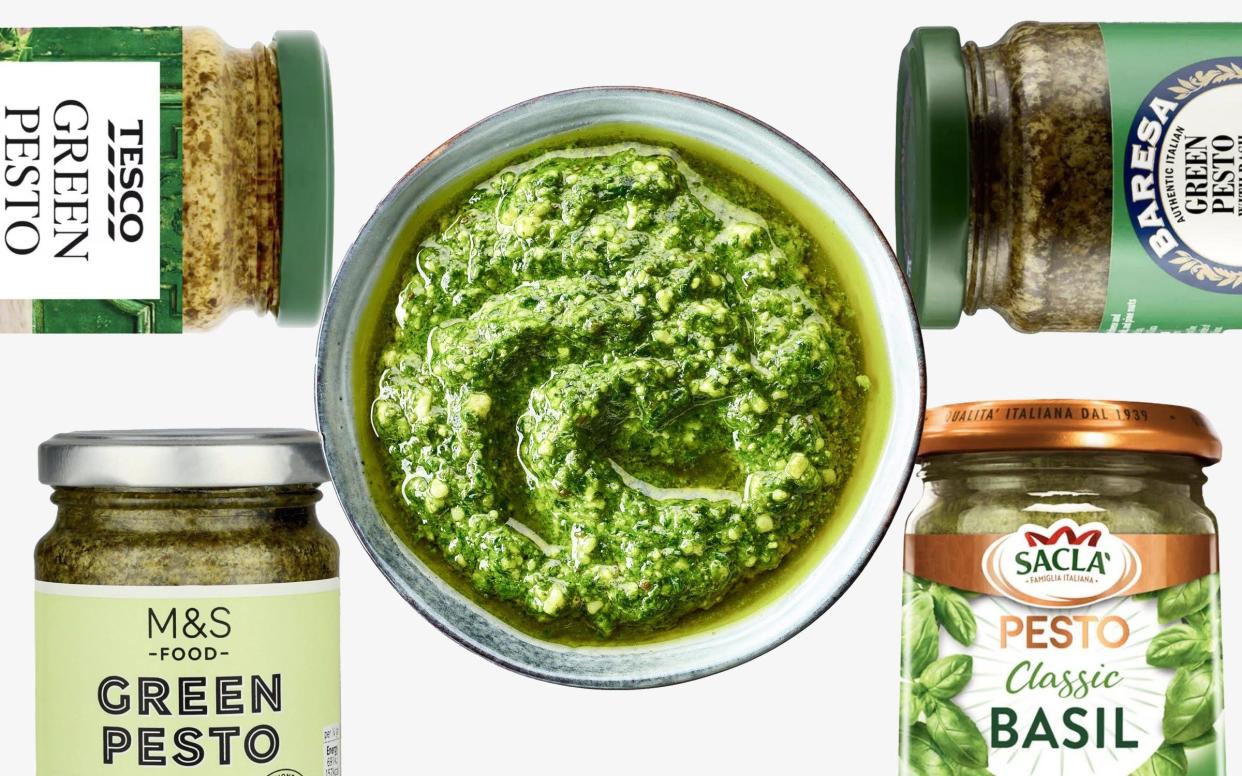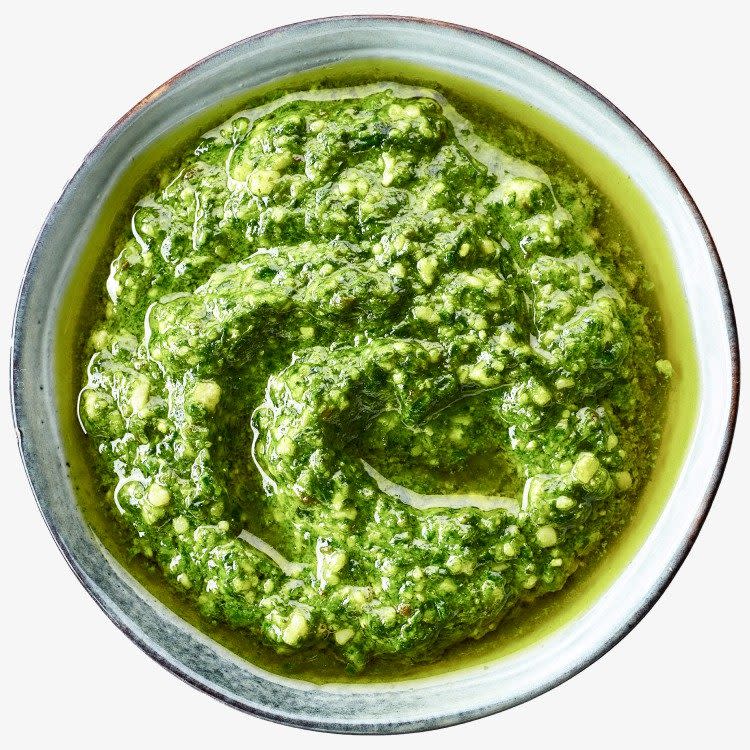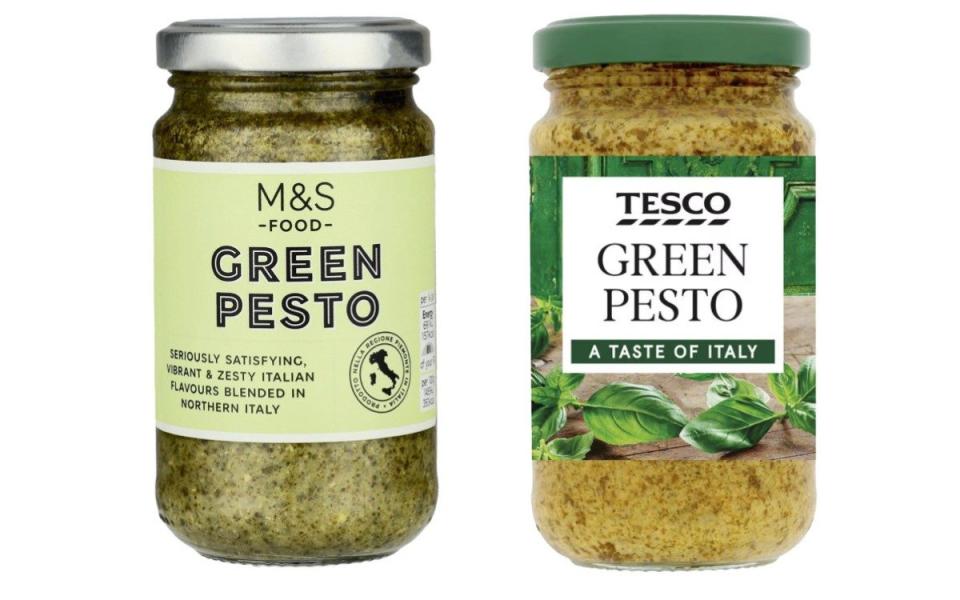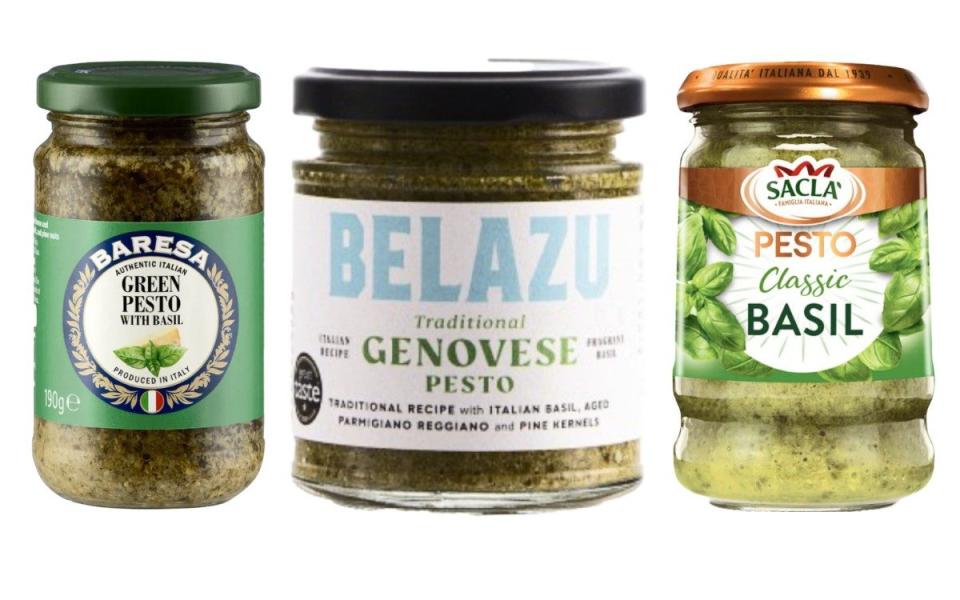‘Saltier than seawater’: I tried 19 jars of supermarket pesto to find the best

Oh, the fuss. When I mentioned online that I was doing a taste test of jarred pesto it unleashed a torrent of comments including “don’t do it!” and “make your own!”
Were they right? Would the pestos all be disgusting? Or was this, dare I say it, snobbery from the kind of people who holiday in Tuscany and follow River Cafe Cookbook recipes religiously? After all, we Brits buy 34 million jars of pesto a year and one in four households has a pot of it in the cupboard.
19 jars later, I can tell you that none of the bottled pesto tastes like fresh pesto, any more than tinned tomato soup tastes like homemade. But that doesn’t mean that some aren’t very much better than others.
According to Sacla, the company that introduced pesto to the UK market in 1991, its own consumer taste tests indicate that we prefer to buy pesto that is salty and cheesy, not herby. This makes sense, as the flavour of basil, pesto’s key ingredient, is fleeting when fresh but turns bitter and soapy if it hangs around.
This can be made much worse by the addition of flavouring, which even if it is “natural flavouring” (not necessarily made from basil at all but from another plant source) can taste overpowering and deeply unnatural. There can be too much acid – usually lactic acid, used as a preservative – in many pesto products, leaving a sickly tang.
Better, then, to seek out jars which deliver on umami (an intense savouriness) and a subtle leafiness, than those which wind up medicinal or (as in the case of one I tried) smacking of cleaning fluid.
The reality is that the jarred stuff is attractive because making pesto from scratch is expensive. Take Anna del Conte’s classic recipe, which involves 20g pine nuts, 50g basil leaves, a clove of garlic, 4 tbsp grated Parmesan, 2 tbsp grated pecorino and 125ml extra virgin oil. Using the cheapest supermarket ingredients, and allowing for those shop-bought 30g bunches of basil being mostly stalk, it’s going to cost around £4 to fill a standard 190g jar.

Not that the ready-made versions use anything like those ingredients. Most include added vegetable fibre (often from peas) which provides cheap bulk to the mix. Potato starch features in some to balance out the sourness of the lactic acid. Then there’s sugar or glucose, neither of which is traditional in pesto recipes.
There are plenty of cost-saving substitutions for the core ingredients, too. Take the basil: some of the pesto I tried was hairily fibrous, leading me to assume that a lot of basil stalk had gone in along with the leaves.
Classic pesto should contain a mix of Parmesan Reggiano, a cow’s milk cheese, and mature pecorino, made with sheep’s milk. Some cheaper jarred versions replace the Parmesan with Grana Padano, a less expensive cow’s milk cheese also made in Northern Italy. It’s a good cheese, if a bit less powerful and complex than Parmesan, but one to avoid if you have an egg allergy, as it is generally made with an egg-based preservative.
Most use cashew nuts instead of traditional pine nuts, and where pine nuts are included it is often so few as to be meaningless. Sacla, Filippo Berio and M&S Green Pesto, for example, all contain more salt than pine nuts, so I can’t believe they really add much to the flavour, although it does allow the producer to claim they include the classic ingredient.
Talking of salt, back in 2017 there was uproar when it was revealed that some brands of pesto were saltier than sea water. While some have dialled levels back a bit, many are generally salt-heavy and some contain three times the salt of others.
A quarter of a 190g jar (which is reckoned to be a portion by supermarkets) can deliver between 0.5g and 1.5g salt depending on the brand, so it’s worth checking the label carefully if you are concerned. With maximum recommended salt levels at 6g a day, that’s a good chunk, so don’t add any more salt to your meal.
And as for snobbism, the supermarkets play up to it with their branding. Cheaper jars are chummily called “Green Pesto” (to differentiate them from “Red Pesto” made from dried tomatoes); perhaps only shoppers with the cash to splash on posh pesto are deemed knowledgeable enough to comprehend “Pesto alla Genovese”.
Don’t be fooled: there’s good and bad in both camps.
The Taste Test
Worsto

I’m surprised to see there’s yoghurt in this one. The texture is quite hairy; I suspect there is a lot of basil stalk in it. It looks like pesto, smells like pesto, but tastes of citric acid and not much else. Grim.
Has the right mix of cheese (both Pecorino and Parmesan) but I wouldn’t have guessed it was pesto with my eyes shut. It’s gritty and has a horrid, yoghurty taste so it wouldn’t work in a salad. Odd.
The ingredients in this look pretty good on paper but it’s pasty in texture. Super savoury but with a strong flavour of cleaning fluid. Unpleasant – like tasting milk and finding it is a day or two out of date.
Has a yoghurty and cooked-cheese taste with very little basil flavour, despite the dark green colour. The flavour is okay but I don’t know if I’d eat it because of the globby, glutinous texture. Not pesto to me.
A thick paste with a gritty texture that catches my throat. It’s got a grassy flavour that’s sour and otherwise bland.
Has a lighter texture than the others and is mildly savoury, but very unremarkable apart from the lactic acid bite.
Great list of ingredients – it’s good to see so much olive oil, basil and actual pine nuts, with Pecorino as well as Parmesan. There’s a nice slick of green oil, too, but the flavour is way too sharp and acidic, overwhelming everything bar a lingering taste of Fairy liquid.
Very pasty and sour. Deeply dull I’m afraid.
Very smooth with a tongue-curling hit of acidity at the back. You can taste some basil but overall it’s cheap-tasting and quite grassy with some sourness. However, it’d stand up to pasta.
For an Italian brand I’d expect this to have more olive oil. It’s pale and homogenous, like pesto mixed with mayonnaise – not at all similar to the real stuff. Cheesy, salty and slightly gritty but not horrid.
Soapy flavour, albeit less obviously sour than the Morrisons ‘The Best’ version. Still not very fresh tasting – more like off milk.
The sourness in this is balanced and it tastes homogenous and savoury. It’s not pesto to me, though – it tastes as if dried, minty herb flavouring has been added. Consistency is ok.
Nubbly texture with some stalky fibres. It has an umami-like hit – as if it’s an added flavouring. The basil flavour is very mild, but there is some acidity there. The nuts come through in this one.
Besto

Soft textured and very olivey, like a salad dressing taste. But there’s too much acid for a posh pesto and I’m not getting any other flavour. A bit odd.
A bit salty with some cheesiness and a soft texture. But the added acid flavour overwhelms everything and tastes soapy and not very fresh.
Made mostly of sunflower oil even though the brand is famous for its olive oil! Classic jarred pesto – reasonably balanced, not too sour but a bit soapy. I think this would work on salmon.
The slick of green oil and rough texture (big chunks of cheese and nuts) make it look homemade. The basil flavour is muted and falls a bit flat but it’s great value; works well in a bowl of pasta.
Salty, cheesy, not very basil-y, but it’s well balanced and isn’t soapy. It makes me think of old-fashioned Italian restaurants. A dash would go a long way in pasta.
A soft texture but rough-looking, with a pleasantly vegetal taste, like a kale pesto. Unctuous and pleasing – you can identify the olive oil, too.

 Yahoo News
Yahoo News 
